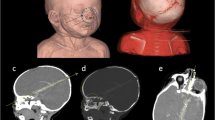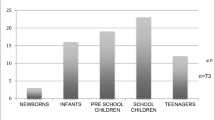Abstract
Objectives
To investigate the contribution of whole-body post-mortem computed tomography (PMCT) in sudden unexpected death in infants and children.
Methods
Forty-seven cases of sudden unexpected death in children investigated with radiographic skeletal survey, whole-body PMCT and autopsy were enrolled. For imaging interpretation, non-specific post-mortem modifications and abnormal findings related to the presumed cause of death were considered separately. All findings were correlated with autopsy findings.
Results
There were 31 boys and 16 girls. Of these, 44 children (93.6 %) were younger than 2 years. The cause of death was found at autopsy in 18 cases (38.3 %), with 4 confirmed as child abuse, 12 as infectious diseases, 1 as metabolic disease and 1 as bowel volvulus. PMCT results were in accordance with autopsy in all but three of these 18 cases. Death remains unexplained in 29 cases (61.7 %) and was correlated with no abnormal findings on PMCT in 27 cases. Major discrepancies between PMCT and autopsy findings concerned pulmonary analysis.
Conclusions
Whole-body PMCT may detect relevant findings that can help to explain sudden unexpected death and is essential for detecting non-accidental injuries. We found broad concordance between autopsy and PMCT, except in a few cases of pneumonia. It is a non-invasive technique acceptable to relatives.
Key Points
• Whole-body post-mortem computed tomography (PMCT) is an effective non-invasive method.
• Whole-body PMCT is essential for detecting child abuse in unexpected death.
• There is concordance on cause of death between PMCT and autopsy.
• Whole-body PMCT could improve autopsy through dissection and sampling guidance.
• PMCT shows findings that may be relevant when parents reject autopsy.





Similar content being viewed by others
Abbreviations
- CNS:
-
central nervous system
- CPA:
-
cardiopulmonary arrest
- CPR:
-
cardiopulmonary resuscitation
- GGO:
-
ground glass opacity
- IVG:
-
intravascular gas
- NAI:
-
non-accidental injury
- PMCT:
-
post-mortem computed tomography
- SAH:
-
subarachnoid haemorrhage
- SDH:
-
subdural haemorrhage
- SUDI:
-
sudden unexpected death in infancy
References
Fleming P, Blair P, Bacon C, Berry J (2000) Sudden unexpected deaths in infancy. The CESDI SUDI studies 1993–1996. The Stationery Office, London
Blair PS, Byard RW, Fleming PJ (2012) Sudden unexpected death in infancy (SUDI): suggested classification and applications to facilitate research activity. Forensic Sci Med Pathol 8:312–315
Hymel KP (2006) Distinguishing sudden infant death syndrome from child abuse fatalities. Pediatrics 118:421–427
Haute Autorité de Santé (2007) Prise en charge en cas de mort inattendue du nourrisson (moins de 2 ans). Recommandations professionnelles. HAS, Saint-Denis. Available via http://www.has-sante.fr/. Accessed 19 June 2010
Kennedy H (2004) Sudden unexpected death in infancy. A multi-agency protocol for care and investigation. The report of a working group convened by The Royal College of Pathologists and The Royal College of Paediatrics and Child Health. RCPath/RCPCH, London
Krous HF, Beckwith JB, Byard RW et al (2004) Sudden infant death syndrome and unclassified sudden infant deaths: a definitional and diagnostic approach. Pediatrics 114:234–238
Brodlie M, Laing IA, Keeling JW, McKenzie KJ (2002) Ten years of neonatal autopsies in tertiary referral centre: retrospective study. BMJ 324:761–763
Newton D, Coffin CM, Clark EB, Lowichik A (2004) How the pediatric autopsy yields valuable information in a vertically integrated health care system. Arch Pathol Lab Med 128:1239–1246
Thali MJ, Jackowski C, Oesterhelweg L, Ross SG, Dirnhofer R (2007) VIRTOPSY—the Swiss virtual autopsy approach. Leg Med (Tokyo) 9:100–104
Bolliger SA, Thali MJ, Ross S, Buck U, Naether S, Vock P (2008) Virtual autopsy using imaging: bridging radiologic and forensic sciences. A review of the Virtopsy and similar projects. Eur Radiol 18:273–282
Scholing M, Saltzherr TP, Fung Kon Jin PH et al (2009) The value of postmortem computed tomography as an alternative for autopsy in trauma victims: a systematic review. Eur Radiol 19:2333–2341
Thali MJ, Braun M, Buck U et al (2005) VIRTOPSY–scientific documentation, reconstruction and animation in forensic: individual and real 3D data based geo-metric approach including optical body/object surface and radiological CT/MRI scanning. J Forensic Sci 50:428–442
Takahashi N, Higuchi T, Shiotani M et al (2012) The effectiveness of postmortem multidetector computed tomography in the detection of fatal findings related to cause of non-traumatic death in the emergency department. Eur Radiol 22:152–160
Roberts IS, Benamore RE, Benbow EW et al (2012) Post-mortem imaging as an alternative to autopsy in the diagnosis of adult deaths: a validation study. Lancet 379:136–142
Oyake Y, Aoki T, Shiotani S et al (2006) Postmortem computed tomography for detecting causes of sudden death in infants and children: retrospective review of cases. Radiat Med 24:493–502
Charlier P, Carlier R, Roffi F et al (2011) Postmortem abdominal CT: assessing normal cadaveric modifications and pathological processes. Eur J Radiol 81:639–647
Bardainne M, Rolland Y, Treguier C et al (1996) Contribution of post mortem skull scanning for the study of sudden infant death. Arch Pediatr 3:661–667
Rambaud C, Imbert MC (1993) Autopsy protocol in the sudden infant death syndrome (SIDS). Ann Pathol 13:131–134
Christe A, Flach P, Ross S et al (2010) Clinical radiology and postmortem imaging (Virtopsy) are not the same: specific and unspecific postmortem signs. Leg Med (Tokyo) 12:215–222
Shiotani S, Kohno M, Ohashi N et al (2002) Hyperattenuating aortic wall on postmortem computed tomography (PMCT). Radiat Med 20:201–206
Shiotani S, Kohno M, Ohashi N, Yamazaki K, Itai Y (2002) Postmortem intravascular high-density fluid level (hypostasis): CT findings. J Comput Assist Tomogr 26:892–893
Jackowski C, Thali M, Aghayev E et al (2006) Postmortem imaging of blood and its characteristics using MSCT and MRI. Int J Legal Med 120:233–240
Shiotani S, Kohno M, Ohashi N, Atake S, Yamazaki K, Nakayama H (2005) Cardiovascular gas on non-traumatic postmortem computed tomography (PMCT): the influence of cardiopulmonary resuscitation. Radiat Med 23:225–229
Yokota H, Yamamoto S, Horikoshi T, Shimofusa R, Ito H (2009) What is the origin of intravascular gas on postmortem computed tomography. Leg Med (Tokyo) 11:S252–S255
Levy AD, Harcke HT, Mallak CT (2010) Postmortem imaging: MDCT features of postmortem change and decomposition. Am J Forensic Med Pathol 31:12–17
Weber MA, Sebire NJ (2009) Postmortem investigation of sudden unexpected death in infancy: current issues and autopsy protocol. Diagn Histopathol 15:510–523
Lonergan GJ, Baker AM, Morey MK, Boos SC (2003) From the archives of the AFIP. Child abuse: radiologic-pathologic correlation. Radiographics 23:811–845
Parizel PM, Ceulemans B, Laridon A, Ozsarlak O, Van Goethem JW, Jorens PG (2003) Cortical hypoxic-ischemic brain damage in shaken-baby (shaken impact) syndrome: value of diffusion-weighted MRI. Pediatr Radiol 33:868–871
Shiotani S, Kohno M, Ohashi N et al (2004) Non-traumatic postmortem computed tomographic (PMCT) findings of the lung. Forensic Sci Int 139:39–48
Shiotani S, Kobayashi T, Hayakawa H, Kikuchi K, Kohno M (2011) Postmortem pulmonary edema: a comparison between immediate and delayed postmortem computed tomography. Leg Med (Tokyo) 13:151–155
Aghayev E, Thali MJ, Sonnenschein M, Jackowski C, Dirnhofer R, Vock P (2007) Post-mortem tissue sampling using computed tomography guidance. Forensic Sci Int 166:199–203
Rossi SE, Franquet T, Volpacchio M, Gimenez A, Aguilar G (2005) Tree-in-bud pattern at thin-section CT of the lungs: radiologic-pathologic overview. Radiographics 25:789–801
Weber MA, Pryce JW, Ashworth MT, Malone M, Sebire NJ (2012) Histological examination in sudden unexpected death in infancy: evidence base for histological sampling. J Clin Pathol 65:58–63
Filograna L, Bolliger SA, Ross SG, Ruder T, Thali MJ (2011) Pros and cons of post-mortem CT imaging on aspiration diagnosis. Leg Med (Tokyo) 13:16–21
Jackowski C, Schweitzer W, Thali M et al (2005) Virtopsy: postmortem imaging of the human heart in situ using MSCT and MRI. Forensic Sci Int 149:11–23
Ross S, Spendlove D, Bolliger S et al (2008) Postmortem whole-body CT angiography: evaluation of two contrast media solutions. AJR Am J Roentgenol 190:1380–1389
Roberts IS, Benamore RE, Peebles C, Roobottom C, Traill ZC (2011) Technical report: diagnosis of coronary artery disease using minimally invasive autopsy: evaluation of a novel method of post-mortem coronary CT angiography. Clin Radiol 66:645–650
Saunders SL, Morgan B, Raj V, Robinson CE, Rutty GN (2011) Targeted post-mortem computed tomography cardiac angiography: proof of concept. Int J Legal Med 125:609–616
Acknowledgments
The authors thank Prof. Yves Gandon for checking the manuscript and Mrs Tracey Westcott for editorial assistance.
Author information
Authors and Affiliations
Corresponding author
Rights and permissions
About this article
Cite this article
Proisy, M., Marchand, A.J., Loget, P. et al. Whole-body post-mortem computed tomography compared with autopsy in the investigation of unexpected death in infants and children. Eur Radiol 23, 1711–1719 (2013). https://doi.org/10.1007/s00330-012-2738-1
Received:
Revised:
Accepted:
Published:
Issue Date:
DOI: https://doi.org/10.1007/s00330-012-2738-1




